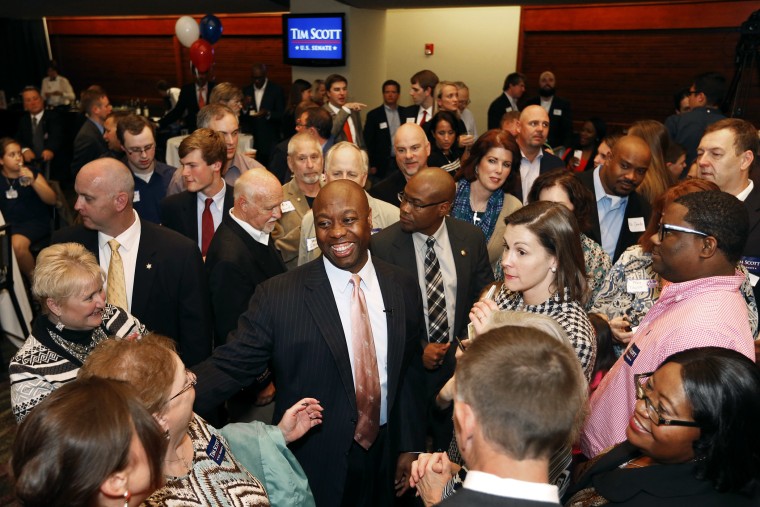Democrats woke up on Wednesday to a Republican Congress-elect, more Republican governors, and more Republican state legislatures poised to enact a conservative agenda. All that would be bad enough in the short term, but the Republican victories exacerbated a problem for Democrats that began in the 2010 midterms: The GOP is growing a deep bench of intriguing and diverse young politicians that Democrats have yet to counter with a star lineup of their own.
RELATED: New kids on the block: Meet the GOP's new senators
Consider what Republicans got in this year's top tier candidates:
- In Iowa, they elected 44-year old Joni Ernst, a candidate whose oft-extreme rhetoric may not play well nationally, but whose charisma, military background, and groundbreaking role as the first female member of Congress from her state offer a new look for the GOP.
- In Colorado, 39-year old Cory Gardner gives Republicans a swing-state politician who combines staunch conservative policy with a moderate tone and appealing personality.
- In Arkansas, they added another relatively young war veteran in Tom Cotton, 37.
- On the House side, 38-year old Mia Love in Utah became the first African-American Republican woman in Congress after coming up short in 2012. Sen. Tim Scott, an underrated and unique conservative voice, became the first African-American to win a Senate election in the south since Reconstruction.
Then consider what the Democrats didn’t get:
- Two promising Democratic women in red states, Michelle Nunn and Alison Lundergan Grimes, fell short in their respective Senate races.
- Anthony Brown, a Harvard-education African-American Iraq veteran raised in an immigrant family, lost in an upset in Maryland’s governor’s race to Republican Larry Hogan. That race had the double effect of taking outgoing Gov. Martin O’Malley, perhaps the most credible Hillary Clinton alternative in 2016, down a peg as well.
- Pro-choice hero Wendy Davis was a long shot in Texas from the minute she announced her candidacy, but her crushing defeat to Republican Greg Abbott – yet another Republican rising star -- knocked out one of the few recent Democrats to generate a national following.
- In Nevada, 34-year old Lucy Flores, whose inspiring rise from gang member to state legislator put her on the national radar, lost her lieutenant governor’s race amid a Republican blowout statewide.
Even the few Democrats with national ticket potential who survived left with their reputation tarnished. Gov. John Hickenlooper, who enjoyed strong popularity early in his tenure, barely survived a backlash to his sweeping progressive agenda since 2012. Virginia Sen. Mark Warner started the race as the state’s most popular political figure, but his closer-than-expected projected victory over Republican Ed Gillespie and a late ethics scandal suggest his strength has waned.
This is an ongoing issue for Democrats.
Republicans have used the midterms to elect new leaders who bring something to the table nationally, whether it’s youth, an interesting biography, a charismatic personal style, or a political resume in a swing state.
RELATED: Election results could force Rand Paul to take major risk
Democrats have had more trouble adding new talent. A lot of this has to do with the 2010 wave: Republicans defeated Democrats in Congress and statehouses so thoroughly, especially in red states, that almost the entire party’s slate of prospects with appeal outside of safe Democratic districts were wiped away.
Here the damage is hard to measure. Could a Democrat like then-Congresswoman Stephanie Herseth Sandlin in South Dakoa have risen to bigger things if she hadn’t lost that year? Would a passionate progressive like then-Congressman Tom Perriello in Virginia be a household name along with Elizabeth Warren?
You can really feel this gap in 2016.
The party’s troubled brand and their various individual foibles have taken a toll on the GOP field, but imagine how thin it would look without the 2010 class: No Florida Sen. Marco Rubio, no Kentucky Sen. Rand Paul, no Ohio Gov. John Kasich, no Wisconsin Gov. Scott Walker. Throw New Jersey Gov. Chris Christie, whose 2009 victory heralded future Democratic losses, into the mix as well. That’s not even counting popular governors like Nevada’s Brian Sandoval and New Mexico’s Susana Martinez who are less likely to run, but cruised to easy re-election on Tuesday and would demand attention if they decided otherwise.
On the Democratic side, Hillary Clinton is by far the biggest heavyweight in either party. Beyond that though, there are few national ticket possibilities on the Democratic side with an equivalent national profile to the GOP names above. Elizabeth Warren is Elizabeth Warren. New York Sen. Kirsten Gillibrand, who replaced Clinton in the Senate, had raised her profile taking on sexual assault in the military. In general, though, there’s no obvious choice for the mantle of “America’s Next Top Democrat” that the average voter could name.
The GOP’s massive success in state legislatures since 2010, which continued on Tuesday, ensures they’ll have a deeper bench to draw from in the next round of elections as well. Not only that, the vast control over redistricting they gained in that election also means Republicans can often trap Democratic legislators and House members in ultra-safe seats where they’re less likely to earn a broader following outside their base.
RELATED: With Joni Ernst win, a star is born in Iowa
With Obama on the way out and the Clinton family heading towards its final act, the party needs to start building its next generation of recognizable leaders. The best way to do that is to stop being blown out in midterms every four years.
